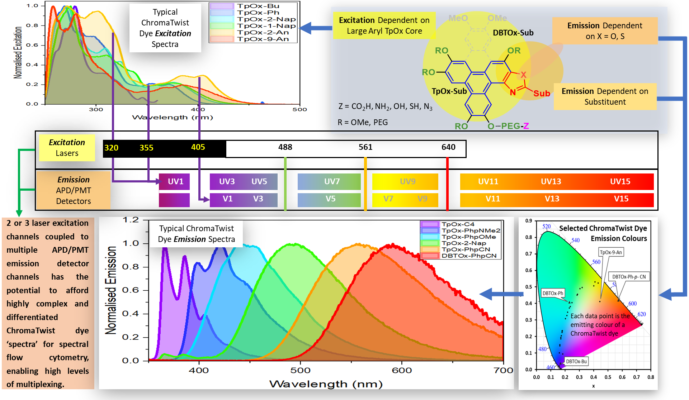Executive Summary
The ChromaTwist molecular dyes have the potential to deliver many D(UV) dye-antibody conjugates for the spectral flow cytometry market with differentiated colours to allow multiplexing beyond the ~50 limit seen to date with the recent emergence – and rapid market uptake – of commercial spectral flow cytometers, e.g. Thermofisher Scientific (Bigfoot), Sony Biotechnology (ID7000), Cytek (Aurora), BD Bioscience (S8). Furthermore, the 320 nm laser excitation development recently introduced by Sony Biotechnology (ID7000), enables the ChromaTwist dyes to be potentially differentiated even further via spectral flow cytomery. ChromaTwist has proof-of-concept data of the dyes’ utility in spectral flow cytometry as discussed below.
The ChromaTwist molecular dyes have the potential to bring a unique set of chemical and photophysical properties which can be exploited by spectral flow cytometry by virtue of their broad UV excitation profile and tunable fluorescent spectral output. These properties should enable 3 laser excitation (320, 355 and 405 nm) and subsequent light emission detection via multiple (i) Avalanche Photo Diode (APD) or (ii) Photo-Multiplier Tube (PMT) detector arrays, which are used in flow cytometry.
In Detail
The typical excitation spectra (Figure 1, top left) of the ChromaTwist molecular dyes shows they cannot only be excited with the 2 common short wavelength lasers (355nm and 405nm) available in multicolour/polychromatic and spectral flow cytometers, but are also excitable at 320 nm aligning with recent Sony Biotechnology ID7000 spectral flow cytometer which integrates a 320 nm laser. Furthermore, the ChromaTwist dye fluorescence output can be interrogated with either APD arrays or PMT arrays, to give a complex spectral output, by virtue of the relatively broad emission profile of the ChromaTwist dyes (Figure 1, bottom middle). Couple these photophysical properties with the ease of chemical manipulation of the dyes, whereby the substituent (Sub on Figure 1, top right) can be easily changed to give emission colours ranging from just below 400nm to over 600nm (Figure 1, bottom right), then ChromaTwist has a potentially very attractive dye portfolio for the emerging spectral flow cytometry market.

Read more about ChromaTwist dye evaluation in Spectral Flow Cytometry.
